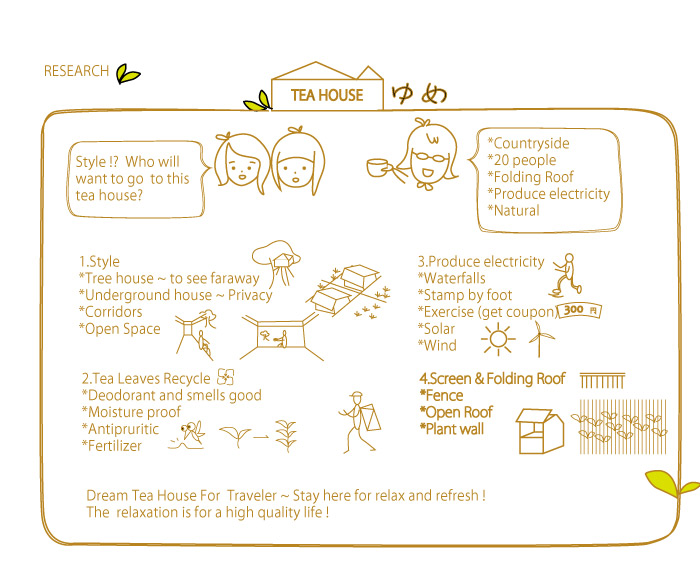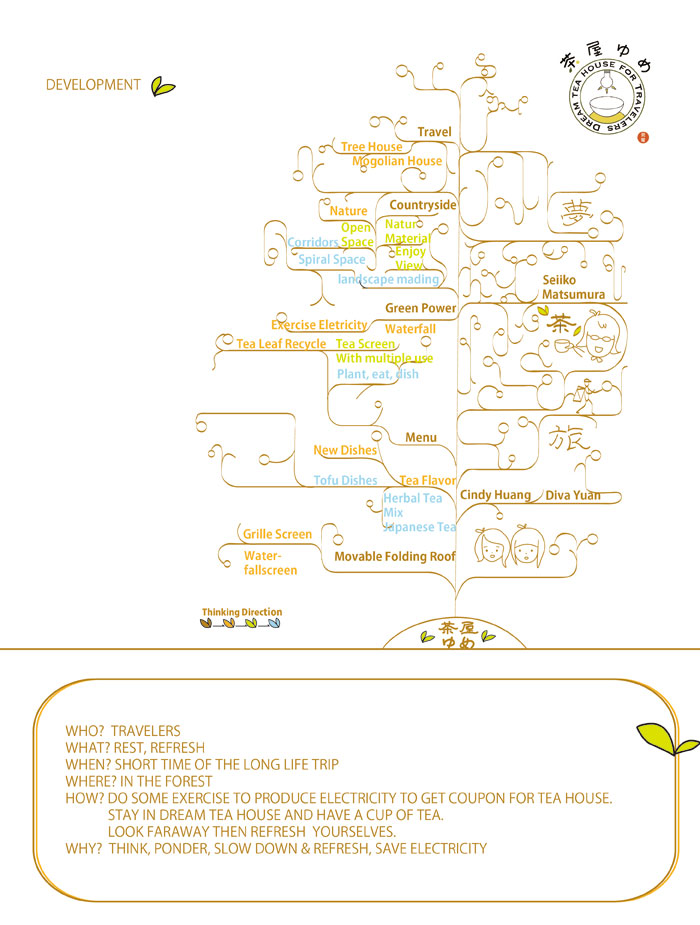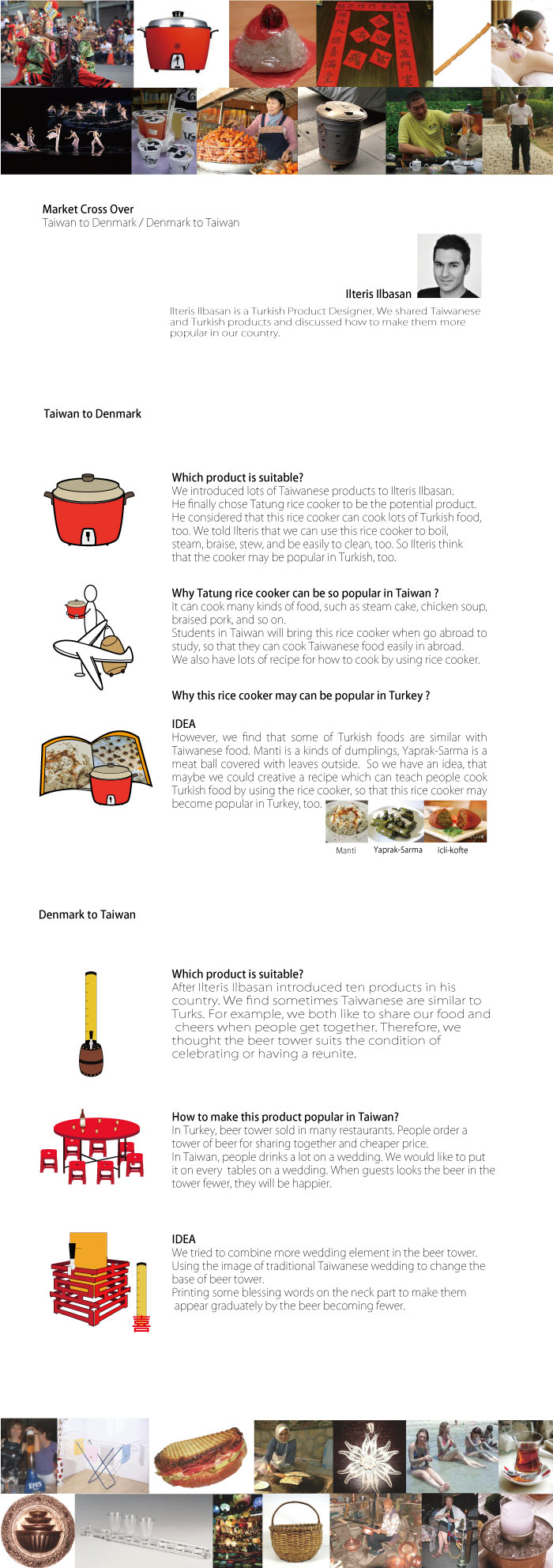|
國際文化設計工作營
Design Cross Over Workshop
4個主題,5種國籍,結合世界各地的設計師,進行一場充滿活力的設計思辨。 國際視訊連線,透過創意和跨領域整合,re思考設計的本質,享受不同文化的背景所激盪出的設計靈感經驗。
Day1:08.06(一)跨國設計案 - 創意啟發
Day2:08.07(二)文化微思考 - 在地驚奇
Day3:08.08(三)完美行銷術 - 國際元素探索
Day4:08.09(四)味蕾交流 - 舌間鑑賞思考
Day5:08.10(五)跨國設計思考流程與方向
Day6:08.11(六)網路成果展準備
Day7:08.12(日)網路成果展 / party time
Mission 1
Project No.1 The Family Dinner
Topic Provider: Thea Borgger / Product Designer
Context
When a family gathers around the dinner table to enjoy a well prepared meal and in tranquil atmosphere, the relaxation and feeling of community can have a very positive effect on the stress levels of the participants. I can sound like a utopian idea in abusy daily program. And all though there are many benefits to this tradition is more or less disappearing.
Eating together unites the family and creates a moment for communication, trust, and learning; many children don't know where the produce comes from. The process of growing food: from seed, to plant, to food is not a part of a common knowledge we can take for granted. How a seed sprouts, grow, and give fruit takes time, water, and care. Using time on the meal both eating and preparing can give children a stronger relationship to food: where it comes from and how it has been prepared. A slower but more giving alternative to our fast-food culture.
Assignment
How can we make it more attractive for the family to prepare and eat a meal together? And how can social, cultural and educational elements be a part of the daily meal?


 Project No.2 Teatime
Project No.2 Teatime
Topic Provider: Seiko Matsumura / Designer
Context
Tea is one of the most popular drinks in the world and to drink tea is a common custom to all nations. In different countries, people drink various teas in different ways.
In Japan, we have a traditional tea ceremony that was conveyed from China and developed the independent style under Japanese culture, religion and spirit.
Japanese tea ceremony can be thought the pursuit of an art of minimalism.
Adopting traditional way we would like to think about ordinary teatime by ordinary people. Teatime is not only for satisfying our thirst but for bringing us the deeling of relax or refresh, lively communication, good ideas...etc.
Teatime is new encounter with oneself, another person or ideas, and sharing comfort.
And one more additional point of view with energy production and energy saving will also be considered. After nuclear accident in Fukushima, energy problem should be considerable even in design.



Assignment
New Style Teatime: generating and saving energy
Suggestions:
1.Conceptual design: teahouse to produce energy
ex. You could have a cup of tea after generating electricity by pedaling or running.
2.Cup design: cup for relax, cup for refresh, cup for communication, cup for exercise...etc.
3.Design of flavor and fragrance: variation of arranged tea by using traditional flavor or material.
ex. Matcha (powered green tea)
4.Design of manner and rule to drink:
ex. Stirring 50 times before drinking
5.Spatial design:
ex. Teahouse with multiple space for relaxing, refreshing, talking,studying, exercising...etc.
ex. Folding and moable teahouse.
Project No.3 Local to Global
Topic Provider: Ilteris / Product Designer
Context
Today's design approach is going through a transformation that makes it closer to the universal design approach than cultural design approach, which is culture-specific and local. Till the latest century, design was shaped and developed locally, dependent on its origin culture and environment. For example, in the ancient times, shelters, hunting tools varied in regions with different climates, depending on the environmental conditions. However, today's world is made smaller by the internet, media and eased transportation, and communication between the two ends of the world is made possible. Therefore, the different design approaches are affected from each other.
"Universal Design" approach is developing faster today. Infact, this approach origins from cultural or individual design approach. For example, what Dieter Rams designed for Braun was as a result of the German culture, whereas they were the products of Rams' own design approach. These products he designed for Braun createed the perception of "German Design". Years later, Apple was inspired by Rams' products and launched new products that resembled Rams' designs, and Apple and their products are now considered to be universal, addressing anyone around the world.
Challenge
Every culture has its unique designs. Some of them are considered universal, whereas some are used only locally and not known by the other culturals, or the worst, long forgotten. Even if they serve for the same purpose, their desgns, uses and interactions would be different if these products belong to different cultures. To discover the design potential in these different concepts with the same function and apply it to new product designed improves the designer's vision ans ability to think universally. When transforming any functional and traditional product from any culture into a universally designed product, the main challenge encountered would be function, ergonomics, interaction and "user's" emotional interaction.
Assignment
As understoon from what is told so far in the brief, inspired by a traditional product of any culture, or a product that serves the same purpose but has different uses in different cultures, a universal product with renovated function and/or interaction if needed will be designed.
Mission 2
Context
There are so Many interesting and localized products in every country, which can only find in their own region. Is there anything worth to be introduced to the rest of the world but yet? Is there anything brilliant in your country, but cannot be found in other countries?
Assignment
Group working: 1 foreign designer ith 2 Taiwanese design students.
Thinking about intriguing and interesting ways to introduce and export local products, ceremony, food, custom...etc.
Recommend one of your local products worth to export to the other countries, then discuss about how to make it successful and interesting.


活動過程

Discussing with Thea Brogger

Discussing with Ilteris Ilbasan

Discussing with Seiko Matsumura

Awarding certificates!
Participating Designers

Thea Brogger / Ilteris Ilbasan / Seiko Matsumura
主辦|都市酵母x水越設計 贊助單位|臺北市政府文化局
日期|2012.08.06(一) - 08.12 (日)
地點|五坪水越(台北市八德路三段199巷4弄6號)
策畫|agua
人員|
水越設計團隊:agua、jolie
邀請設計師:Thea Brogger, Ilteris Ilbasan, Seiko Matsumura
參與學員:
楊雅竹/台南應用科技大學商品設計系
楊仁/台北科技大學文化事業發展學系
丁萱/台灣科技大學創意設計系
林資芬/國立雲林科技大學 工業設計系
袁家芃/台北市私立大同大學工業設計系
黃薇臻/台北科技大學創新設計所
曾嬿圩/南藝大應用藝術研究所纖維組
延伸閱讀:可以吃的風景
|
